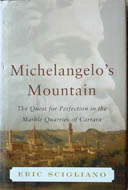 Local author Eric Scigliano writes a fascinating history and travelogue taking us through yesterday and today in Carrara, the “marble belt” of Italy. His book is truly a biography for stone carvers.
Local author Eric Scigliano writes a fascinating history and travelogue taking us through yesterday and today in Carrara, the “marble belt” of Italy. His book is truly a biography for stone carvers.
Scigliano’s ancestors were skilled carvatori or quarrymen, those who split out and brought down the large blocks of marble from the mountains surrounding Carrara. A carvatori was a respected professional and not considered a common laborer. Scigliano gives us a textured and colorful picture of the culture and character of the area’s inhabitants, their proud and defiant politics as well as their cuisine and love of music. The Carrara of today still maintains some of the character of Michelangelo’s time. However, the area is now all but depleted of statuario, and rivalries between quarries have grown, as has tourism.
Numerous biographies of Michelangelo’s life exist but Scigliano includes biographical material that focuses on his passion and attachment for the marble of Carrara. The marble was often referred to as “living stone,” for its unique potential to generate a living and flesh like quality. Throughout his life Michelangelo spent months at a time in Carrara looking for stone without flaws for his colossal projects. He liked the Carrara area, and liked avoiding some of the pressures and politics related to his commissions. Much has been written about the demands on Michelangelo as the protégé of the Florentine ruling family the Medici and his commissions with the Vatican, most notably with Pope Julius. Scigliano takes us through the details with an easy and modern style.
One of the things that make this book such an enjoyable read is the way the author often segues into interesting tangential supporting material when describing a particular aspect of a subject. For example, while describing stone tools of the period and Michelangelo’s preference for the use of the forked chisel, he refers to a conversation he had with our own Sabah Al-Dhaher. Sabah had explained, “The forked chisel shows you the form. It’s like drawing on the stone. You are drawing in three dimensions.”
The book is quite a ride. You’ll learn a little Italian, about carvatori tools and techniques of the times, psychoanalytic interpretations of Michelangelo, Vermont granite quarry politics, the history of the stone that became the sculpture David, mineralogy, details of the cleaning of the Sistine Chapel ceiling and some of the ideological differences between Michelangelo and Leonardo da Vinci. It contains a little of something for everyone.

